This will be the final installment of the RX3 and RX4 comparisons. We’ve got one more coming up after this, and that’s the RX4-to-KLR 650 comparis0n. And then, another cool and quick review…the BMW GS 310. Yep, I rode one of those yesterday to get a feel for how it compares to the RX3. That will be in another review. For now, on to the RX3 and RX4 final comparison in this series…
Take a look at the swingarms on the RX3 and the RX4. The RX4 has a much beefier unit, as you can see below.
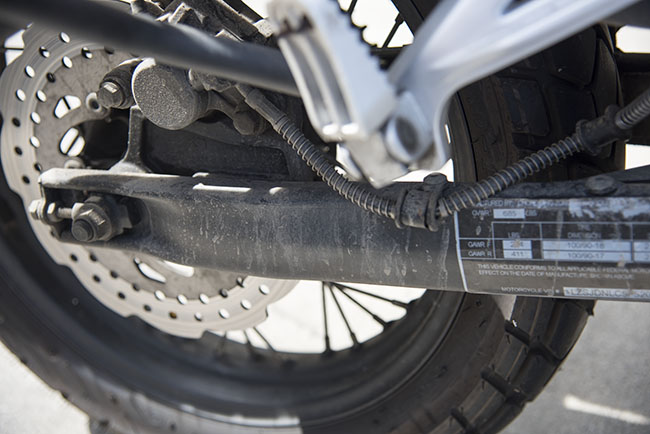
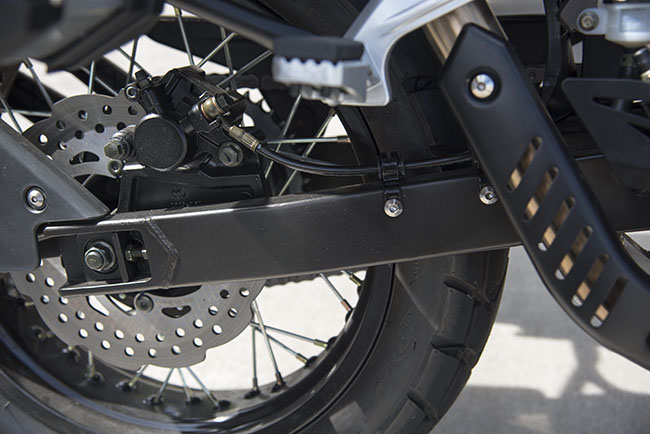
Overall, the RX4 swingarm appears to be much better design than that on the RX3. The only aspect of the RX3’s swingarm that I think I like better is the axle adjustment design. On the RX3, the threaded adjusters can be used to move the rear wheel forward or backward. On the RX4, it looks like Zongshen took a more conventional approach, where the adjusters can be used to move the wheel rearward, but you have to manually push the wheel forward.
I may have already mentioned this next point in an earlier blog, but I’ll mention it again. On the RX4, the exhaust pipe sweeps down and under the engine, and then it sweeps up again to the muffler behind the engine. The RX3 has an upswept pipe.
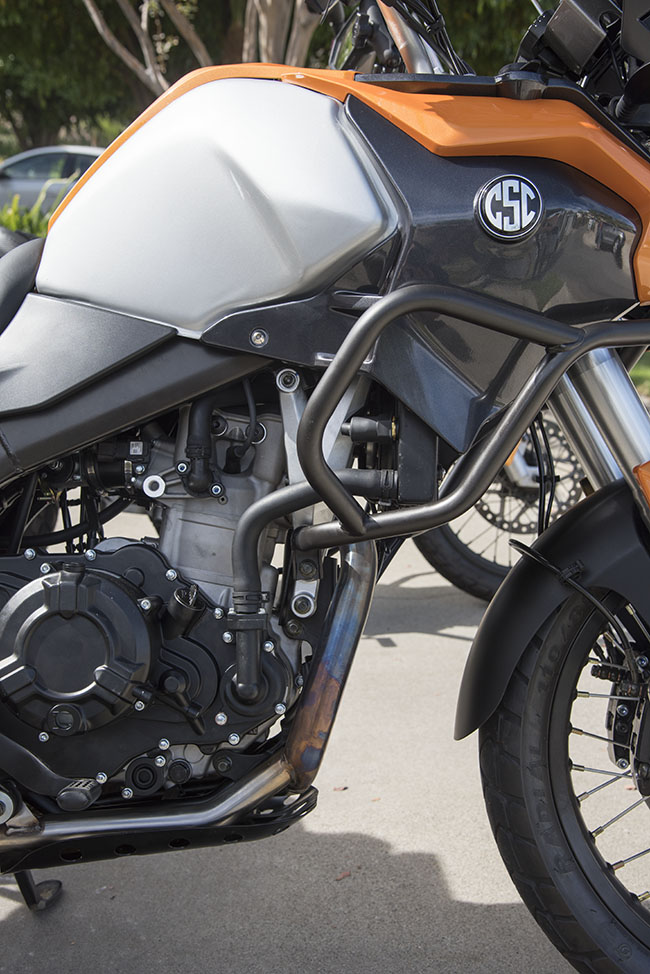
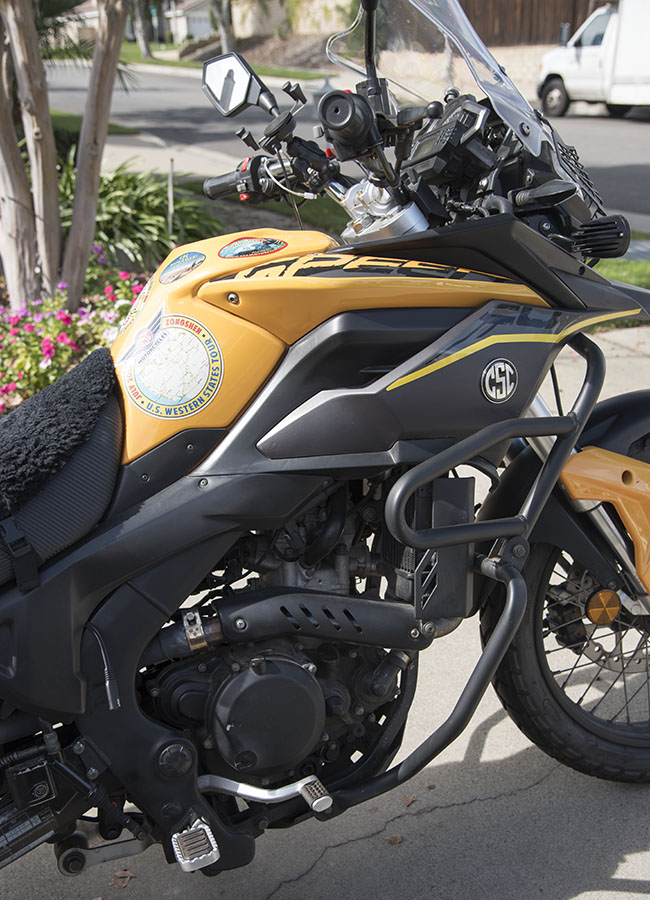
The purist will undoubtedly flood the forums with comments about the RX4’s downswept pipe. My reaction is: Meh. It’s the same approach as used on my Triumph Tiger. Upswept, downswept, six to one, half a dozen to the other. As the Germans say, machst nicht. That is, unless you’re changing the oil or adding oil. Then the RX4’s downswept pipe (and the improved access it offers to the oil fill ports) starts looking pretty good.
Here’s another significant difference: The radiator. The RX4 uses a single large radiator, compared to the RX3’s two smaller radiators.
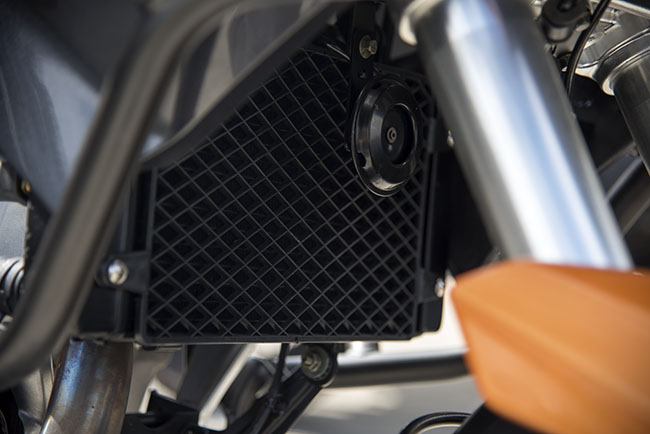
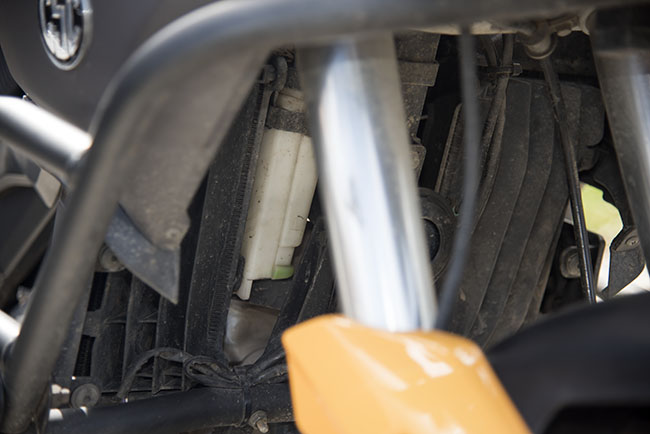
I like the RX4 radiator approach better. Simple is better in the engineering world, and a single radiator makes a lot more sense to me.
Moving on, we’ll next take a look at the grips and controls on the RX3 and the RX4. The RX3 photos you see here are my RX3, which is a 2015 model. In 2015, the RX3 did not have bar end balancers, but Zongshen added these in 2016 and beyond. Also, the 2015 RX3 had chromed bars, all subsequent years had subdued silver paint on the bars.
When Zongshen made the RX3 handlebar change, I wondered why they messed with something that worked so well. There was more to the story than I knew at the time. It basically went like this: The Chinese motorcycle industry took a major hit and underwent a significant shakeout in recent years. The US motorcycle market did, too. Here at home, the market dropped to 50% of its former levels with the Great Recession of 2008, and it has never moved much beyond that point since. We had a double whammy here: Banks and lending companies stopped giving 4th, 5th, and 6th mortgages to folks wanting to buy motorcycles (I’m exaggerating, but only slightly), and our demographics changed. Older guys aren’t buying bikes like they used to (they’re aging out), and Millenials are more interested in cell phones and self-driving cars than they are in motorcycles. And while all of this was going on, the industry here in the US continued (and continues) to offer outsized and overpriced choices. In China, there has similarly been a double whammy, but the two strikes are of a different nature. China is concentrating its population in the cities, and (incredibly) China is outlawing motorcycles in its cities. I know, it’s nuts, but it is what it is.
Anyway, all of this caught up with the Chinese motorcycle industry, and a lot of lower level motorcycle component suppliers in China finally called it a day in 2015-2016. That’s what resulted in the need for a new RX3 handlebar supplier going into the 2016 model year. With that change, Zongshen included bar end weights, which I think were unnecessary. Nah, change that: I know they were unnecessary, because I have a 2015 RX3 with no bar end weights and a zillion miles on the clock, and I’ve never had an issue with vibration.
All righty then…to dial this back to today, the bottom line is that both the RX3 and the RX4 have bar end weights. But not mine, because it’s a 2015 RX3. With that in mind, here we go…
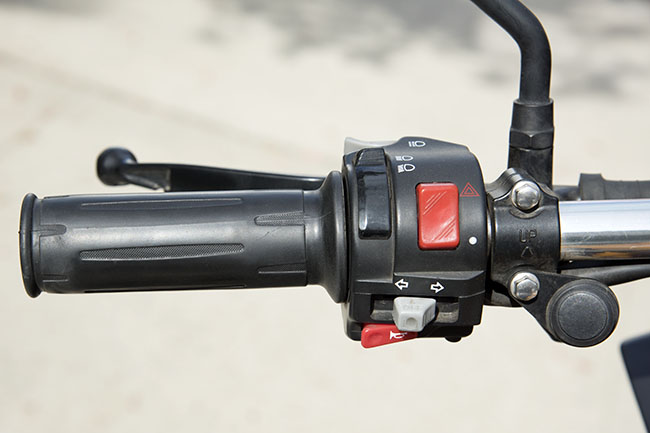
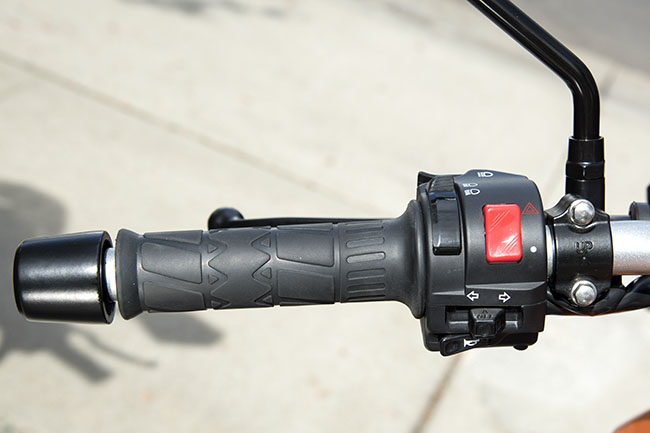
So, about that sloppy bar-end fit on the left side of the RX4 preproduction prototype: While I was disappointed in this minor detail, I have to point out that it was the only area on the motorcycle that was poorly fit. Every other aspect of the RX4 (and I mean literally every other bit related to fit and finish) was absolutely world class. The bike just screams quality. The paint, the fit, the finish, everything. Except that sloppy left side bar-end weight.
Moving on to the right side of the bike, here’s the right side grip and control area on my RX3. Note the A2, A1, and O switch; it controls the RX3’s underseat accessory plugs.

Here’s the same view of the RX4’s right side grip.
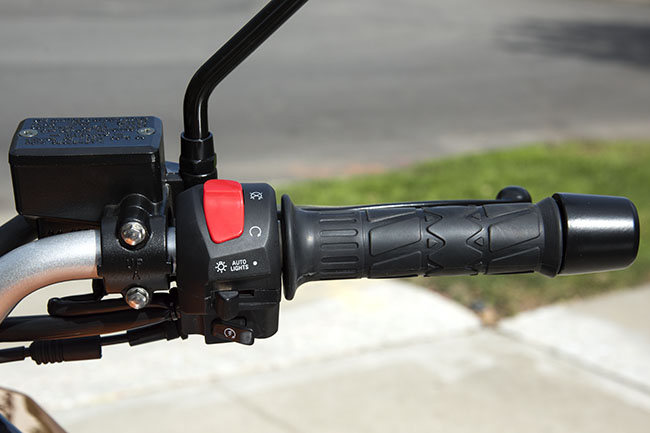
The photo above shows the RX4 preproduction bike, which has the headlight switch for on, auto, and off. I’m told the US configuration bikes will only have the on and auto positions. The on position turns on the headlight; the auto position leaves the LED headlight outline on all the time but only turns the headlight on when it senses it is dark. The A1 and A2 switch for the underseat accessory plugs will be controlled by an optional CSC-unique handlebar-mounted switch. At least that’s the plan as of this writing.
On this issue of bar-end weights: Like I said above, vibration is a non-issue on both bikes. If I concentrate on trying to feel it, I guess I would say the RX4 has a barely-detectable higher vibration level than the RX3, but you have to really focus on trying to tell the difference. I’d drop the bar-end weights on both bikes. But then, I don’t make a million motorcycles a year. Zongshen does.
The big difference in the wheels between the RX4 and the RX3 is that the RX3 has spoked steel rims and cast wheels are not an option. On the RX4, the wheels are spoked aluminum rims, and cast aluminum wheels are an option.

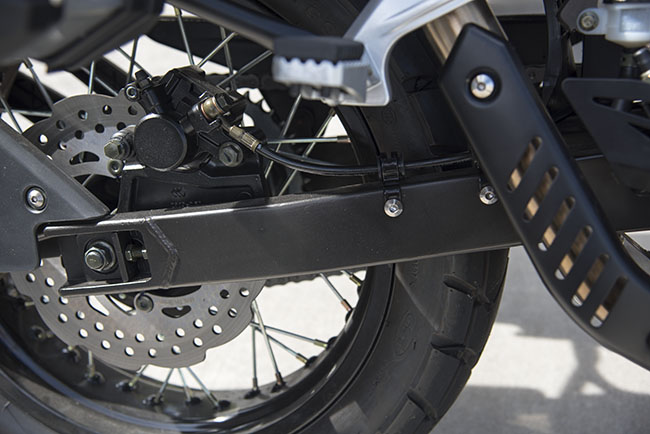
For comparison, here’s the wheel and tire on the front of my RX3.
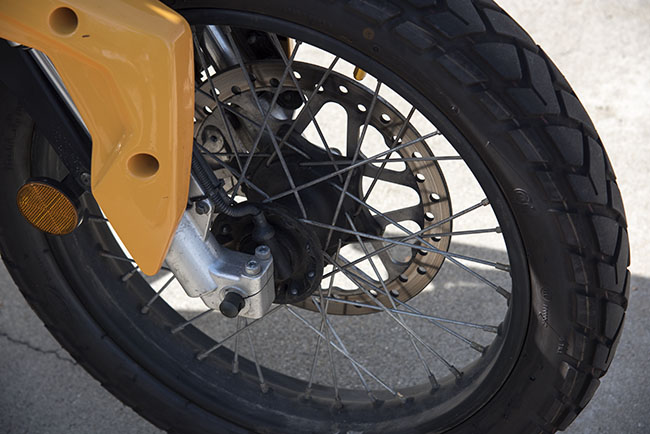
The last area I’ll describe is the dash and instrumentation, and that part is easy: They are identical. Well, almost. The instrumentation is the same. The dash is a little different in that on the RX3, the USB and 12V chargers are optional accessories; on the RX4, they are standard equipment.
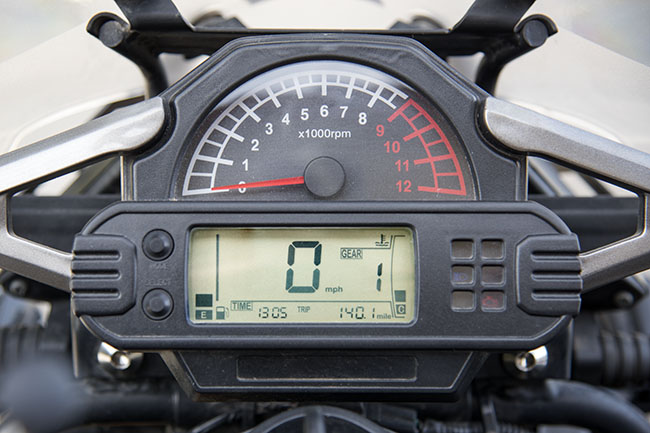
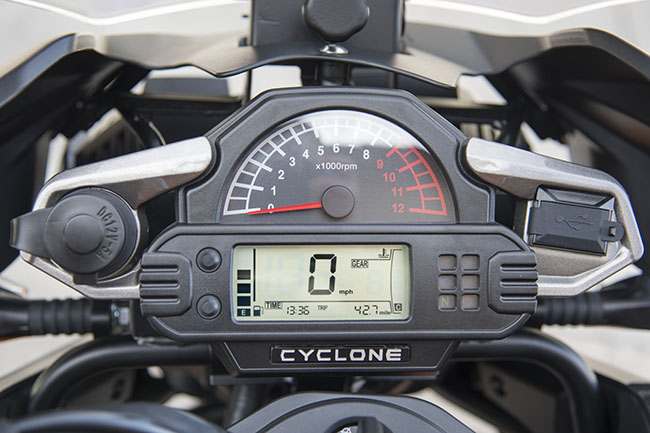
The RX4 instruments, which are identical to the RX3’s (including the 10-12% optimistic speedometers). Note the standard-equipment USB and 12V accessory outlets to the left and right of the speedometer. And folks, that wraps it up on the RX3-versus-RX4 comparisons. It was fun, and it was really fun to be the first to evaluate the RX4 and publish these findings on it here on the ExhaustNotes blog. My overall take is that the RX4 is a quality machine. It’s a little heavier than the RX3, but I suppose that’s to be expected on a motorcycle with nearly twice the displacement of the RX3. The handling and freeway performance is a substantial notch above the RX3. I don’t believe anyone is offering a comparable, fully-equipped adventure touring package at any price in the 450cc class, and that makes this motorcycle noteworthy (especially in view of the fact that this displacement is so obviously perfect for a serious roadburner). CSC asked me to mention that they are taking deposits now, and here’s the page where you can do that.
If you’d like to read all of the RX3-to-RX4 comparisons, here’s the page to do that. Stay tuned, because we have an RX4-to-KLR comparison coming up soon, and (as mentioned above), we’ll also be publishing a quick ride review of the BMW GS 310. BMW has a significantly different path to market than does CSC, and that difference (to me) is even more interesting than is a comparison between the two motorcycles. We’ll talk about that, too.
Don’t forget to consider signing up for our email updates list. You can do that by entering your email address on the widget at the top right of this page (if you’re on a desktop) or at the bottom of this blog (if you’re using your smartphone to read this blog). We’re having a contest to give a away a free copy of one of our motobooks in December if your name is on our email list. And we won’t share you email address with anyone else.
Yesterday was a fun day. I was at Brown BMW in the morning for my GS 310 ride, and I got to chat with Bob Brown a bit while I was there. Then it was over to CSC to visit with the guys there. I’m happy to report that both places were hopping. This morning, I’m off to the rifle range to evaluate a few new loads, and tomorrow, it’s the International Motorcycle Show in Long Beach (watch for the photos here on the ExhaustNotes blog). Good times, folks.

Although the bar-end weights add a little “weight” and width, they can serve as modest crash protection. I’m surprised to see the same redline for both bikes. I wonder if that’s just a cost saving issue to avoid changing the display.
I don’t know if that was the thinking, Alvin. The RX3 has a rev limiter that is higher than the redline, but both the cutoff and the redline are well above where the useful power lives. I’ve found that to be around 7000-8000 rpm on my RX3. I didn’t exercise the RX4 much above that on the bike I rode, partly because it was so new, but mostly because I didn’t need to. I found that the RX4 rev range felt about the same to me as the RX3 (i.e., the big power exists in the 6500 to 8000 rpm range). THe RX4 had substantially more power at the bottom end than the RX3, as might be expected from a bike with nearly the twice the displacement of the RX3.
On the bar end business, different strokes for different folks, I guess. I didn’t find them necessary on my RX3. Your mileage may vary.
Csc is planning on making the auxillary plug switch optional? It effectively takes a very cool aspect of the bike and renders it useless. Ofcourse its possible to install it yourself, but it seems theres not really any need to leave out that feature; it lets any shmo put some lights on the front and connect them directly to the aux output with the headache of the switch configuration.
That’s my understanding, Jake. You should check with CSC and let then know your feelings. The switch was readily available on the RX3; on the RX4 it was not because the switch location is needed for the headlight and auto-light switch.
They have minor difference but they both work good. Love my 250 for now . I’ll trade it in after 50,000 miles
Get an orange one when you trade up. It’s a faster color, you know.
Joe – Excellent info as always! Great to see the beefier construction in several areas are helping to justify the added weight. Given this is your last-ish installment, but that there’s a KLR comparo coming, I’ve put together quite a list of comments and queries for you. Thanks in advanced for humoring them and me.
I for one appreciate the bar end weights, as my hands go numb after every extended (4-6hr) excursion on my 2015 RX33, though some white-knuckling around semis, and in general to fight the front end oscillations one often earns when nearing “terminal velocity”, was unavoidable, and likely related. Your continued affirmation the RX4 is much more planted and capable at freeway speeds, along with the added bar weights, will go a long way to remedy these issues for us RX4 hopefuls.
On the fit and finish, it’s also great to hear you are impressed, but I know some of us were hoping for beefier hand control bits, the horn and turn signal as examples. IMHO, they just don’t have anywhere nearly the solid feel of their Euro/Japanese counterparts. As a road cyclist all too familiar with the similar gripes (preferences?) between SRAM/Shimano’s top-end brifters, I do understand it could also be personal sensitivities here. Same goes for the dash, though. The most notable leaps between bike generations of all brands lately is in the electronics, and I’d really thought we’d see a jump from Zongshen in that regard for this new model. Yes, the ABS is welcome, and I’m “ok” with the carry-over speedo/tach we’re getting, but other prevalent Chinese makers seem to really excel here by comparison. I mean, c’mon… the super dim neutral/engine/high-beam/etc LED’s not remedied in four model years – an eternity in this modern era – just screams lazy.
Yes, I know these are but minor gripes (constructive criticisms!) for a bike of such great value, yet they are legitimate, and items that could easily be addressed.
Anyway, along with your excellent subjective anecdotes, I’ve also been hoping for a few more data-driven bits over the last few installments (and to be really fair, some aren’t on the CSC site yet either)… Here are the specs I’m really wanting, if you’d be so kind to measure a few:
1. What are the RX4’s front rotor and fork diameters? The less-than-awesome brakes have been a consistent soft spot on the RX3, so this is of particular interest. I’d suspect the added front mass might justify larger fork diameters as well.
2. Output is listed by CSC at 40.2hp, though most reports abroad claim ~43. Do you think this is related to the more robust catalyst it likely needs to pass CARB testing? If so, do you think the fact CSC has published a number indicates they’re satisfied the current mule design will pass muster w/CARB? I guess I’m ultimately curious if/how the USA models’ exhaust differ from those in other markets, and if a simple swap to non-CARB/CSC exhaust, or even just the can, might yield those extra horses for little $$, and still essentially meet lesser EPA requirements by which most of us are constrained. Understandably, this can wouldn’t go through a separate, prohibitively expensive EPA cert, but you know future owners are going to ask about this.
3. Though it indeed looks identical, can you confirm output of the dash USB? Most phones really benefit from a 2.4 or even 2.0A output. For many, like my phablet-esque iPhone 7 Plus, it’s essential. Yes, I could simply insert a 12V wart to the left, but in practice as I’ve seen on my RX3, this creates a major weakness in water tightness, and I’ve ruined 2 or 3 high-quality/current USB adapters due to moisture this way, as well as degraded the 12V port itself. The market seems to be moving to heavier use of phones instead of dedicated GPS units, because duh, they make apps for that. The USB output should improve accordingly.
4. Love love LOVE the auto headlight sensor and new LED ring, but I actually wish CSC would have/keep a switch option for off. Often when I park my bike at night, I’m stopping to fiddle with GPS/phone and want to keep it charging with the headlight/engine off and not worry about the headlight draining the battery. Given further the headlight’s “high” non-LED current drain, and also that folks often switch over to LiFePo batteries as an upgrade to save weight (and weight up top where it really matters), lends added merit to this thought.
Again Joe, many thanks again for all your info, and I’m really looking forward to the KLR comparo, as well as getting my spiffy new RX4 in the spring!
Cheers!
Nick
Joe,
I really wish Zongshen would make the turn signal indicators more visible (bigger and brighter). I had trouble with the turn signal cancel on my RX3, and the only way that I could somewhat quickly verify they were off during daylight hours was to look directly at the lights since the indicators on the instrument cluster required more head-down time as well as taking a hand off of the handlebars to provide shade over the instrument cluster. Even that was difficult due to the viewing angle from the driver’s seat. An even better option would be self-cancelling signals. Other bikes have had them for years.
Yup. What he said. No argument here.
Joe,
Thank you for the great comparison. Photos and descriptions were fantastic. The RX4 sounds awesome, and if I didn’t already love my RX3, I might consider the upgrade. However, as I get older, lighter is better. More controlled and moderate acceleration is better. Slower tire wear is better. Slower chain wear is better. My RX3 does everything that I need, so I will happily keep it for now.
BTW, maybe I missed it, but did you give mileage figures for the RX4, distance on a full tank, actual weight? Do you think Gresh could manage a burnout on it?
I’m looking forward to the RX4-KLR write-up, as well as the BMW GS 310 write-up.
John, I did not test the fuel economy personally, although I provided the Zongshen-supplied figure and a bit of conjecture on the range.
Gresh can do anything. You were there in Port Orford when he did that burnout on the RX3. I think he could do a burnout on a bicycle.
Like this? https://www.youtube.com/watch?v=FnMgq1PY2vo
🙂
Charles.
Love it.
Joe – Excellent info as always! Great to see the beefier construction in several areas are helping to justify the added weight. Given this is your last-ish installment, but that there’s a KLR comparo coming, I’ve put together quite the list of comments and queries for you. Thanks in advanced for humoring them and me.
I for one appreciate the bar end weights, as my hands go numb after every extended (4-6hr) excursion on my 2015 RX3, though some white-knuckling around semi’s, and in general to fight the front end oscillations one often “earns” when nearing terminal velocity, was unavoidable, and likely related. Your continued affirmation the RX4 is much more planted and capable at freeway speeds, along with the added bar weights, will go a long way to remedy these issues for us RX4 hopefuls.
On the fit and finish, it’s also great to hear you are impressed, but I know some of us were hoping for beefier hand control bits, the horn and turn signal as examples. IMHO, they just don’t have anywhere near the solid feel of their Euro/Japanese counterparts. As a road cyclist all too familiar with the similar gripes (preferences?) between SRAM/Shimano’s top-end brifters, I do concede it could also be personal sensitivities here. Same goes for the dash, though. The most notable leaps between bike generations of all brands lately are in the electronics, and I’d really thought we’d see a jump from Zongshen in that regard for this new model. Yes, the ABS is welcome, and I’m ok with the carry-over speedo/tach we’re getting, but other prevalent Chinese makers seem to really excel here by comparison. I mean, c’mon… the near-invisible neutral/engine/high-beam/etc LED’s not remedied in what will be FIVE model years – an eternity in this modern era – just screams lazy.
Yes, I know these are but minor gripes (constructive criticisms!) for a bike of such great value, yet they are minor *and* legitimate, and items that could easily be addressed.
Anyway, to match your excellently-subjective anecdotes, I’ve longed for a few more data-driven bits over the installments (and to be really fair, some aren’t on the CSC site yet either)… Here are the specs I’m really wanting, if you’d be so kind to measure a few:
1. What are the RX4’s front rotor and fork diameters? The less-than-awesome brakes have been a consistent soft spot on the RX3, so this is of particular interest. I’d suspect the added front mass might justify larger fork diameters as well.
2. Output is listed by CSC at 40.2hp, though most reports abroad claim ~43. Do you think this is related to the more robust catalyst it likely needs to pass CARB testing? If so, do you think the fact CSC has published a number indicates they’re satisfied the current mule design will pass muster w/CARB? I guess I’m ultimately curious if/how the USA models’ exhaust differ from those in other markets, and if a simple swap to non-CARB/CSC exhaust, or even just the can, might yield those extra ponies for little $$, and still essentially meet lesser EPA requirements by which most of us are constrained. Understandably, if another Zongshen can exists, it wouldn’t justify a separate, prohibitively expensive EPA cert for non-Cali buyers, but you know future owners are going to ask about this.
3. Though it indeed looks identical, can you confirm output of the dash USB? Most phones really benefit from a 2.4 or even 2.0A output. For many, like my phablet-esque iPhone 7 Plus, it’s essential. Yes, I could simply insert a 12V wart to the left, but in practice as I’ve seen on my RX3, this creates a major weakness in water tightness, and I’ve ruined 2 or 3 high-quality/current USB adapters due to moisture this way, as well as degraded the 12V port itself. The market seems to be moving to heavier use of phones instead of dedicated GPS units, because duh, they make apps for that. The USB output should improve accordingly.
4. Love love LOVE the auto headlight sensor and new LED ring, but I actually wish CSC would have/keep a switch option for off. Often when I park my bike at night, I’m stopping to fiddle with GPS/phone and want to keep it charging with the headlight/engine off, and not worry about the headlight draining the battery. Given further the headlight’s “high” non-LED current drain, and also that folks often switch over to LiFePo batteries as an upgrade to save weight (and weight up top where it really matters), lends added merit to this thought.
Again Joe, many thanks for all your info, and I’m really looking forward to the KLR comparo, as well as getting my spiffy new RX4 in the spring!
Cheers!
Nick
Thanks, Nick. No plans for additional testing or review by yours truly on the RX4 at this time, but if I get the chance, I’ll see if I can get the info you ask for. I think contacting CSC directly would be a better bet, though. Regarding the horsepower figures, I also saw the two numbers. When I contacted Zongshen, they told me the correct number was 40.2, not 43.
Thanks for all you do Joe. Looking forward to GS 310 article.
Just finished the first draft. Look for it sometime next week. Lots of good stuff to get on the blog.
Hey Joe,
Remember the VW “Macht Nichts sticks”?
Yep, sure do. I also vaguely remember the three years of German I took in high school.
Any noticeable difference in wind protection between the windshields? Does the adjustability of the RX4 make any difference?
The RX4 windshield is higher, although the top is still well below the line of sight. I think they both work well. The RX4 might be a little better. It worked well for me as delivered, so I did not attempt to adjust it.
Joe, I heard the RX3 and RX4 use the same seat. Is this true? I ask because I might want to put the narrow seat the RX3 uses.
Yes, it is the same seat.
Hey Joe,
Thank you for the comparison between the RX3 and RX4. The one comparison that I have not seen yet is, finding neutral. On the RX3, finding neutral is like finding a needle in a hay stack. Will the RX4 neutral be any better or the same? Like many of the bloggers, I too am anxious for Spring of 2019 to arrive to receive my RX4. Again, thank you and keep up the good investigative work.
Steven N.
Steven, thanks for asking that question. It was something I meant to mention but did not. I found that on the preproduction sample I rode, neutral was very easy to find.
Great question.